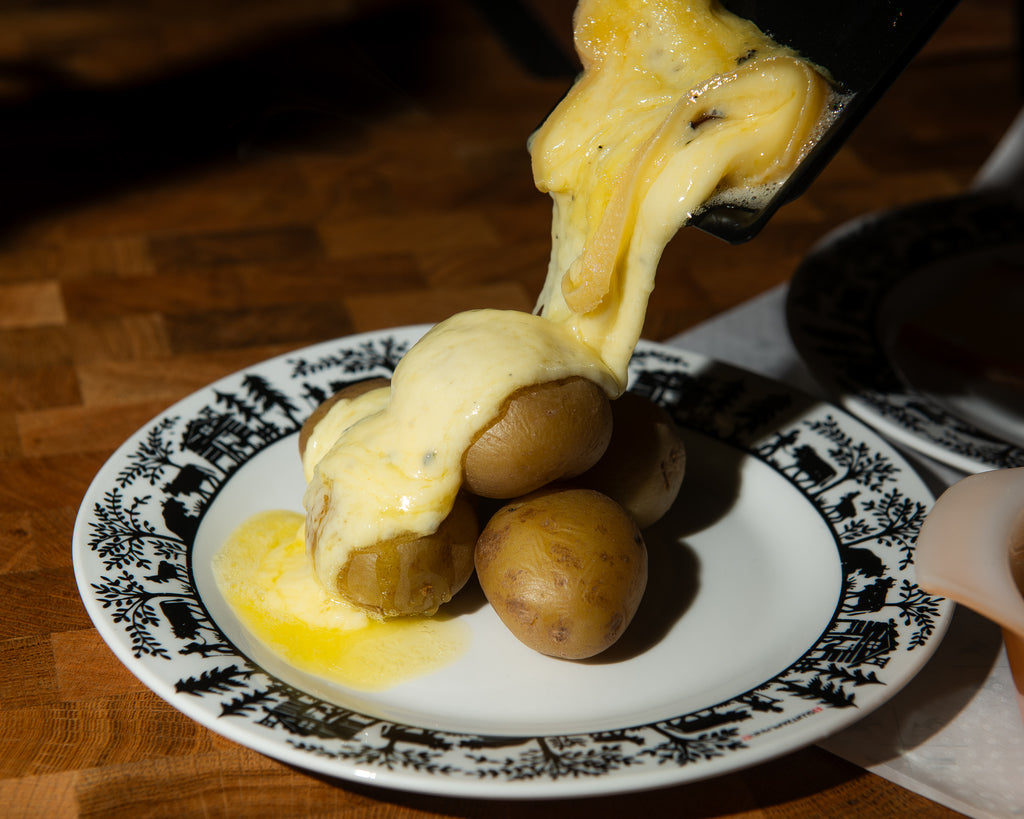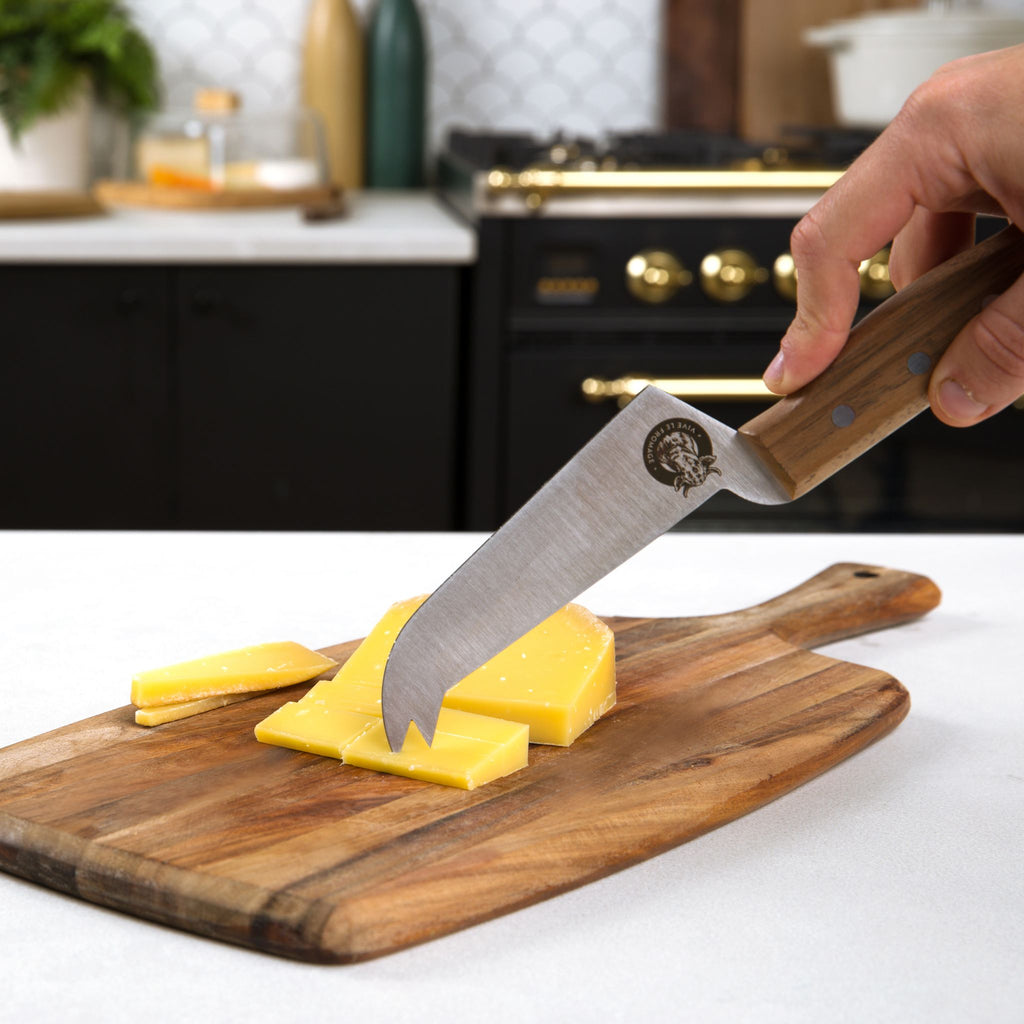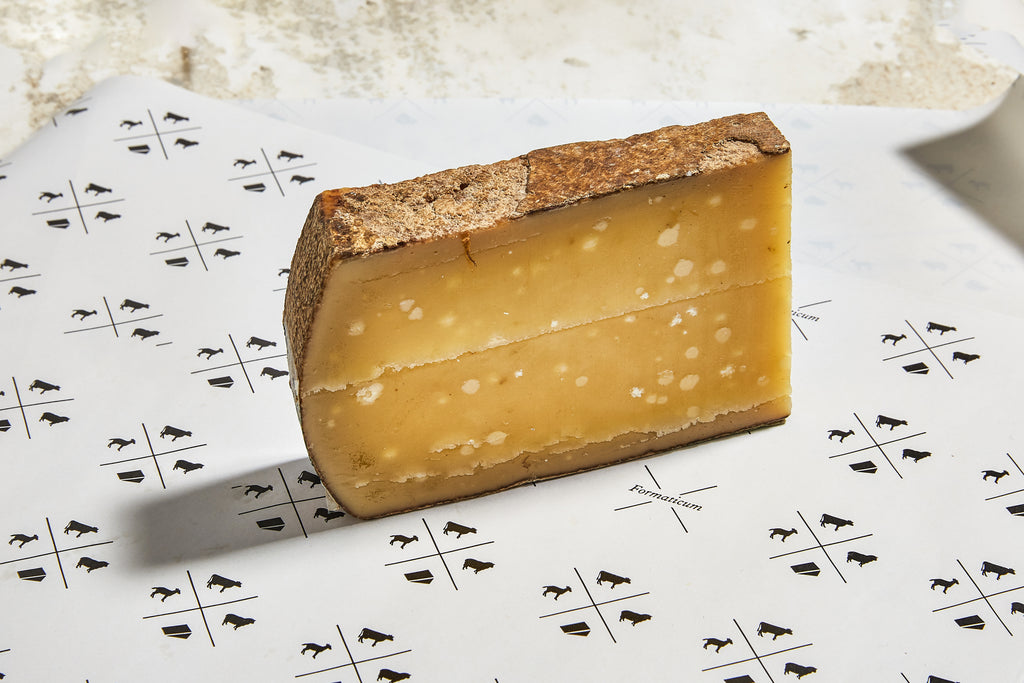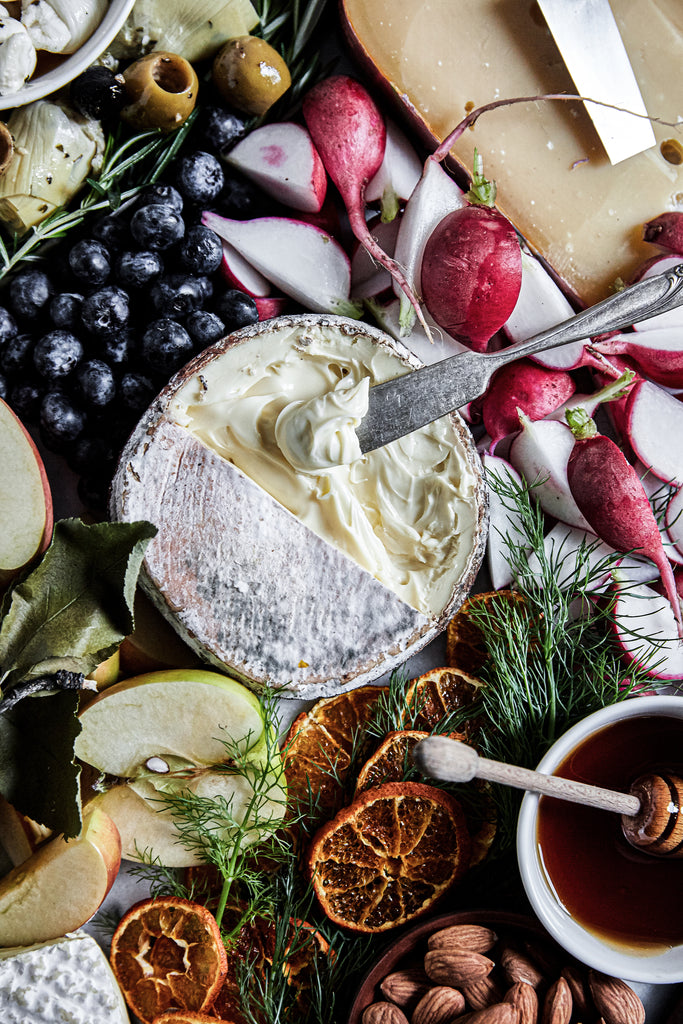The Raclette Revival

The colder weather means one thing for cheese lovers: Raclette season. If you haven't tried this iconic melty, funky, dish, now is the perfect time! Originating in Switzerland around the 13th century, the name “raclette” comes from the French word “racler,” which means “to scrape," referring to how the cheese is traditionally melted and scraped onto a plate of potatoes, roasted vegetables, and various meats. Raclette was originally created by Alpine shepherds as a way to preserve surplus spring and summer milk so that it could be enjoyed and utilized during the harsh winters when milk was scarce. Today, Raclette is made and enjoyed all over the world, most notably in the Alpine regions of France and Switzerland. This washed-rind cow's milk cheese is the perfect balance of nutty and funky, and when melted, becomes a silky, luxurious treat.
So, how do you decide which Raclette(s) to try when there are so many different and delicious options? Well, here at Formaticum, we've done the hard work of trying many different Raclettes so that we can help you make this very tough decision. Here are the most popular types of Raclette you will find at the cheese counter or section of your grocery store:
- Swiss Raclette
- French Raclette
- Domestic Raclette (look for Reading Raclette from VT or Alpinage Raclette from WI)
- Flavor-added Raclette (popular flavors include truffle, peppercorn, chili, and herb)
If you're hosting a Raclette party, we recommend serving a minimum of 2 different varieties to keep things interesting. Our favorite combination is 2 classic Raclettes from the above categories, and at least 1 flavored Raclette.
Once you've chosen your Raclette varieties, how do you know how much to serve? We recommend accounting for 1/2lb per adult as a main course, or 1/4lb per adult as an appetizer. If you are using a personal Raclette grill, you can ask your cheesemonger to slice it for you, or you can use the Formaticum Soft Cheese Knife to help you get the perfect thin slices that will melt evenly and slide off the grill like silk.
Don't forget to wrap any leftover Raclette in Formaticum cheese paper to keep that beautiful flavor fresh, ensuring that you experience the full flavor of those lush Alpine pastures, as the cheesemakers intended.
Make Friends With Your Monger

There is no better way to maximize your experience at a cheese counter than by interacting with your cheesemonger and utilizing their knowledge and passion to create the perfect holiday cheese platter. Cheesemongers are a treasure trove of information with an almost encyclopedic knowledge of the products in their case. They are a huge resource to customers who want to try something new, expand their palate, or are in search of something specific. They know which cheeses are in peak condition and are always excited to tell you about their current favorites.
If you didn't know, cheeses are a seasonal product, and winter is one of the best times to try a special cheese for the holidays. From the thick and luscious, woodsy and bacony paste of spruce-wrapped Rush Creek Reserve to the slightly smoky, caramelized onion flavors of a Gruyere Alpage, to creamy, buttery truffle-infused Brie, your local cheesemonger is ready and willing to cut you a piece.
Next time you're at a cheese counter, strike up a conversation with your cheesemonger and ask for a sample of your next favorite cheese. By doing so, you can expand your cheese knowledge, and create a perfect holiday cheese platter that will impress your guests and satisfy everyone's taste buds. And don't forget to grab a carton of Cheese Storage Bags to keep your leftover cheese fresh until it's time to make the next platter!
The Big Question: How Long Will My Cheese Last in My Fridge?

One of the most common questions we get here at Formaticum is, "how long will my cheese last?" and we're here to answer that question for you! The answer is….there is no one right answer. Cheese is a living, breathing product, and a gastronomic miracle, and there are a variety of factors that affect a cheese's shelf life. Keep reading to learn more about how to store your cheese in the fridge to keep it in peak condition as long as possible.
1. When purchasing cheese, choose pieces that were cut as recently as possible. Having a cheesemonger cut a piece for you fresh from the wheel is the best option, but if you don't have access to a cut-to-order cheese counter, pay attention to the pack date and Best By dates on the cheese at your grocery store. Look for pieces that were cut in the last few days, or that have a Best By date of 2-4 weeks from the day you are shopping.
2. Store your cheese in material designed to keep cheese fresh. Formaticum cheese storage bags and paper are specially designed by European cheese paper companies and are used in many of the world's best cheese shops. While plastic wrap suffocates your cheese and imparts off flavors, Formaticum cheese storage products allow your cheese to breathe and prevent it from drying out, which means your cheese will be in peak condition longer! If you buy cheese wrapped in plastic, transfer it to a Formaticum bag or sheet as soon as possible before placing it in the fridge. Remember to gently scrape the face of the cheese with a knife before placing it in the bag or paper, in order to remove any plastic flavor or excess moisture/butterfat that may cause the cheese to deteriorate more quickly.
3. Dedicate a section of your fridge to just cheese. We recommend storing your cheese in a drawer or other area of your fridge where it will not be as susceptible to temperature fluctuations from opening and closing the door, and it will not pick up any aromas or flavors from other items in your fridge. And make sure that your fridge is not too cold - frozen cheese, when thawed, develops an unpleasant texture.
4. Buy less cheese, more often. Cheese is not an immortal product and the quality will inevitably deteriorate over time. Cheese was meant to be eaten, not to sit in your fridge for months! The best way to ensure that your cheese will taste as fresh as possible, every time, is to buy fresh pieces as often as possible. There is a reason our bags were designed to be the size they are! We recommend accounting for 1-2oz per cheese, per adult, when buying cheese. Of course, you can always adjust as needed.
We know that good cheese can be expensive, so we want to help you protect your investment! Use these tips to help save your cheese, and honor the hard work of the makers.
Cheese & Charcuterie Board Tips for the Holidays

The holiday season is almost here, and cheese lovers everywhere are planning their cheese and charcuterie party platters to usher in another year of food, fun, and friendship. Here are some cheesemonger-approved tips for creating an impressive and unique platter that will wow your guests.
When creating your platter, it's important to choose a variety of cheese styles, textures, and milk types to accommodate all palates and preferences. Triple cream cheeses like Delice de Bourgogne or Brillat-Savarin are a classic festive pairing with bubbles like Champagne and Prosecco, because the effervescence of the wine cuts through the high butterfat content of the cheese and lifts the flavor on the palate. Alpine cheeses like Gruyere and Beaufort are iconic seasonal cheeses with complex onion and floral flavors that will transport you to the Swiss mountaintops where the cows graze on lush alpine pastures to create the rich, flavorful milk for these cheeses. Aged chèvre is always a hit, and don't forget the farmhouse Manchego or crystalline goat Gouda!
Use Formaticum Mini Cheese Knives to cut each cheese into bite-sized pieces to make it easy for guests to enjoy, using our Cut Guide video below as a reference. Don't forget to use all edible elements, including garnish, and include things like candied nuts, dried fruits, sliced charcuterie, and local honey.
It's also important to follow cheese platter etiquette to make sure everyone can enjoy the spread! If you don't like the Brie rind, we recommend cut a complete piece of Brie off the platter and separate the rind on your own plate, instead of scooping the paste out of the rind on the platter.
Left with extra cheese after the party? Store your leftovers in Formaticum Cheese Storage Bags or Paper until you're ready to use them as a snack or in a hearty recipe - leftover cheese is a perfect excuse to make mac & cheese, grilled cheese, quiche, omelettes, and even mashed potatoes.
Most importantly, have fun and get creative.

Welcome to the formaticum Blog
Our home to share our cheese chronicles and more.
Categories
Recent Posts
Women's History Month: March 2025
Beginner's Guide to Cheese Pairings
Upcoming Events
Connect with Us
Join the Newsletter
Sign up to receive special offers, new product releases, updates from the cheese shop, and more.









